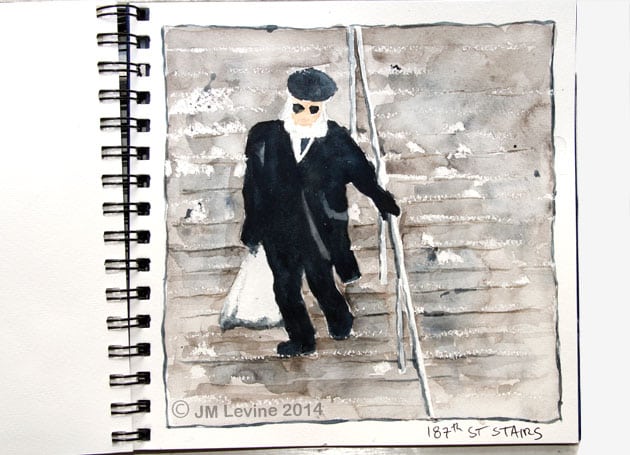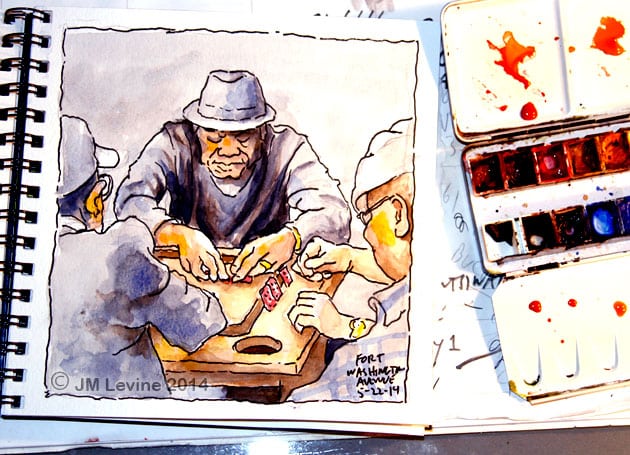
These are my most recent watercolors painted in Washington Heights. They feature the markets, bus stops, street people, and Orthodox Jews around Broadway, Fort Washington and St. Nicholas Avenues. Thanks to my teacher, the master Timothy Clark, I am finally beginning to see the light and gain the ability to paint it. But with a little thought these same lessons can be applied to improve medical skills.

Through watercolor I have discovered new ways to piece together my visual environment. In a recent class while doing a demonstration, Tim said, “I am not teaching you how to paint, I am teaching you how to see.” The ability to see is of course a prerequisite to making a painting, and this is the same thing I tell medical students and residents in training when they rotate through my wound clinic. The ability to see is a required skill in any therapeutic encounter, but especially when diagnosing and treating wounds.

When discussing a patient I often ask the resident, “What was the first thing you saw when you walked into the room?” Often my question is met with puzzled looks. The newly trained doctor, whose skills regarding observation either haven’t been taught or are perhaps yet undeveloped, may not appreciate the process of seeing. The reliance on laboratory tests and written reports from imaging procedures too often supersedes the simplest and most direct diagnostic tool – using the senses to collect critical information about the patient. For most doctors the time looking at patients is minute compared to the time looking at computer screens.

Just as the watercolor teacher can teach the art of seeing by demonstrating light, shadow, form, and color, medical students can indeed be taught to synthesize the vast amount of science and physiology they have memorized into visual skill at the bedside. Wound care, because it is so highly based on direct observation, lends itself to reliance on the process of seeing, but this is necessary for most situations when diagnosing illness.

When a patient presents with a medical problem, for example, it is important to observe their body movement, physical habitus, and skin color. Important clues appear with regard to emotional state, pain, anemia, hypoxia, and other pathologies. As the patient reveals their symptoms, the physician is already assembling the observations into a differential diagnosis, to be supplemented with hands-on physical examination and diagnostic tests. Too often, the process of observation is missed, the doctor is too distracted to hear the symptoms, and there is a rush to type the computerized orders for blood tests and imaging studies and enter the billing codes for insurance reimbursement. The critical steps of seeing and thinking become truncated, information is lost, and a therapeutic relationship becomes shallow.

And so I return to my sketch pad, looking at the world and trying to decipher tonal scales, color temperature, and form. I think about the lessons my art teachers have given me and struggle with my brushes and paints trying to get it right. When I am with my patients I am acutely aware that I employ the same skills to become a better doctor, and try to impart lessons on seeing to my students. Tim Clark’s goal might be to teach art, but his lessons can easily be translated to medicine.
* * * * * * * * * * * * * * *
Capturing the Bolivian Sunlight in Watercolor
Sketching the Subway and the Disappearance of Time
Sketching at the Museo del Prado
Urban Sketching in Portland, Oregon
Watercolor and Urban Sketching in Italy

xj9cvw
kv8kwx
ponf0e
w0ajki
w3t9cn
5vq16e
0o6e4p
qb4jb9
w1roc6
xfpxl3
tueb90
w90483
qhprjp
msv99o
opui8c
y5duz7
be4k4k
Jeff I left GSA after 35+ years and realize I am no longer on your email list, I have started sketching and loving it. You inspired me and I want to get back on your list. Linda Harootyan
Really love the sentiments portrayed by the paintings. Would have loved to see the paintings in real-time.
Tim Clark has a fine art ability to see what is in any chosen view that he can coalesce with his amazing watercolor, design and drawing techniques to create a masterpiece of art that stuns the viewer with its beauty, and appeal to the heart, mind and spirit. His art pieces vibrate with the life and feeling he creates in them. Tim is a best of show, world class artist whose watercolors will shine in any venue…
I have studied with Tim off and on for 20 years. His insights always get stronger! Keep up with the good painting!
Love your work. Thanks to Tim Clark for sharing it in his newsletter.
Your paintings and sketches are very well observed and recorded. I enjoy the choices you make. Relating observation in art to your other field is
wonderful. We all need to work on integrating our lives into a meaningful whole. Thank you for this insight and to Tim Clark for pointing me to your blog.
Great article. i am a nurse & your observations are just as valuable to us as it is to the doctor. I have taken some life drawing classes from Timothy Clark & he is a great teacher who imparts more than just art as you say in your article. By the way, your paintings are really good as well. Too bad you are so far away from where I live, I would have liked to meet you.
I am familiar with Tim Clark’s watercolors from an exhibition a couple of years ago in California, and I hope to study with him in the future. The art of “seeing” that you are practicing as a doctor and an artist is elemental to our intelligent interpretation of the world around us. It is a lovely thing that Mr Clark has helped his students to refine this practice, and that his students find illumination in their daily pursuits as well.
I have studied with Tim for many years. I have traveled with him to many foreign places and painted. I have never found another artist/teacher that gave such direction and insight as he does. I only wish that I could have done more and continued to travel with him to absorb more philosophy on the feelings he puts into his paintings. We have all been blessed with his touch. I am happy that it overflows into other fields.
I enjoyed your insight, Jeff. I, too, have learned from Tim. A common comment on my work is “You don’t have to include everything!” Choose the important elements. Look for the light and choose what you want to say. As in painting, as in life, look for importance and choose what you want to say. Thanks, Tim.
It reminds me of a favorite quote which is “the eye sees what the mind knows”. Think about it, if we have the knowledge of something are we more likely to see it, that is probably what separates an expert or experienced clinician from the beginner. We see things in patients that the novice clinician has yet to being into their visual field of practice. Whether in healthcare or painting, may we all have the right teachers and mentors that help us to develop our scope of seeing.